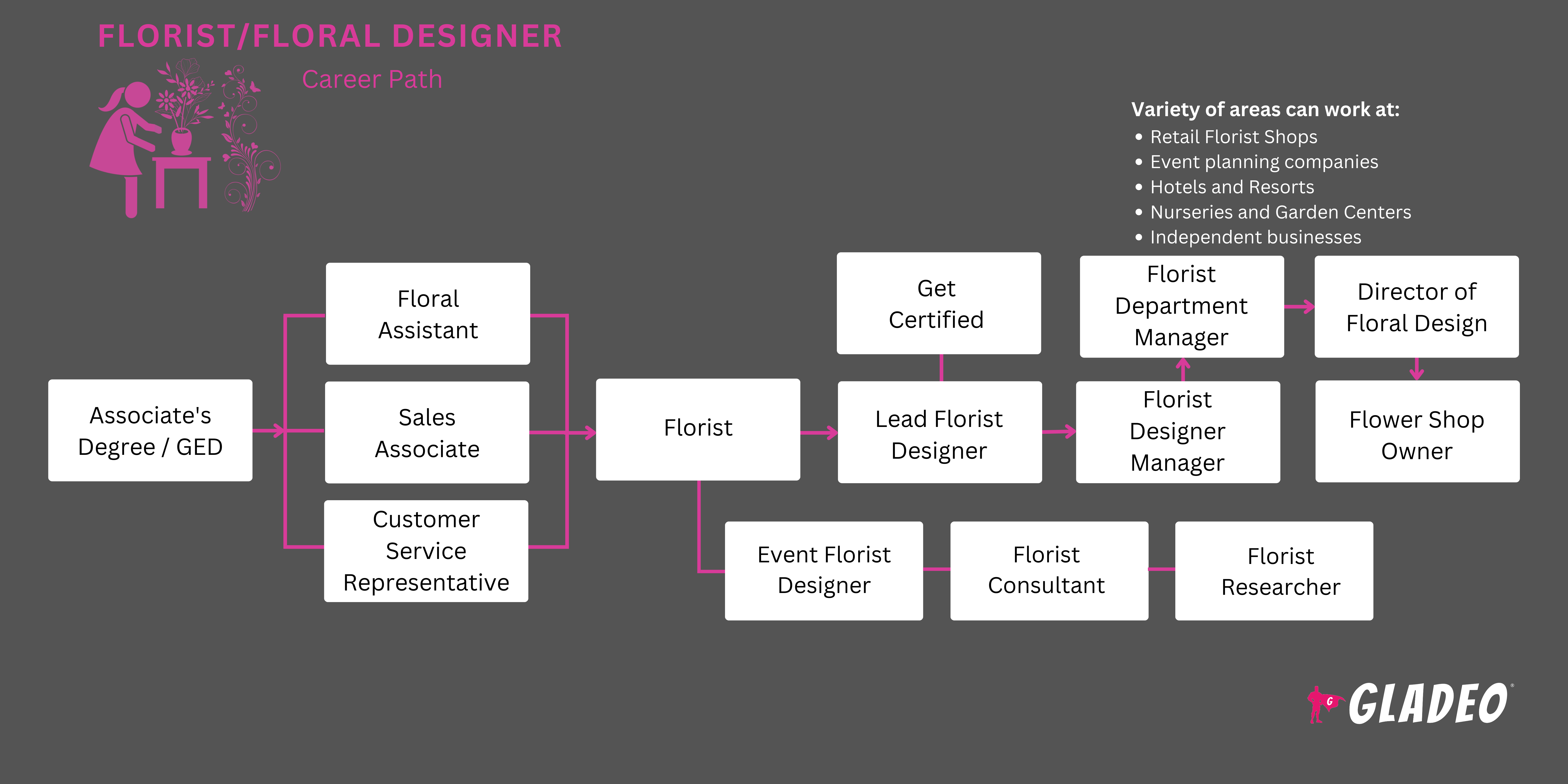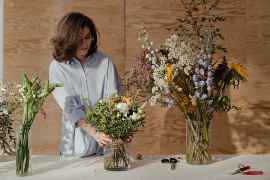Focos de atención
Diseñador, Artista floral, Empleado floral, Especialista en departamentos florales, Diseñador floral, Florista, Decorador de bodas
Regalar flores en ocasiones especiales es una tradición que se remonta a la antigua cultura egipcia. Hoy en día, seguimos regalando flores para expresar sentimientos tan variados como el amor o el pésame. Los floristas (o diseñadores florales, si lo prefiere) son los orgullosos guardianes de esta antigua costumbre. Se abastecen de flores frescas de granjas y mayoristas locales y las seleccionan y combinan cuidadosamente en vistosos arreglos decorativos o ramos envueltos.
Como expertos en este campo único y relativamente pequeño, los floristas suelen ayudar a los clientes a decidir qué flores son adecuadas para cada ocasión y presupuesto. Muchos floristas trabajan por cuenta propia, dirigen pequeños negocios locales y ofrecen servicios de reparto. Otros pueden trabajar en los departamentos florales de grandes tiendas o supermercados. Independientemente de dónde trabajen, los floristas son artistas creativos y empáticos que ofrecen piezas florales significativas diseñadas para marcar la diferencia en las vidas de sus destinatarios.
- Pasar tiempo trabajando tranquilamente con flores y plantas
- Tener una vía de expresión creativa
- Saber que tu trabajo ayudará a que alguien se sienta mejor
- Posibilidad de tener y gestionar tu propia pequeña empresa
Horario de trabajo
- Los floristas pueden trabajar a tiempo completo o parcial. Los que tienen un negocio pueden hacer horas extras para asegurarse de que hay suficientes flores frescas y otras existencias a mano, de que la tienda está ordenada y es atractiva a la vista, de que se cuida al personal, de que los vehículos de reparto están en buenas condiciones, de que el marketing funciona bien y de que la contabilidad se lleva correctamente. También es probable que se necesiten horas extra en temporadas de mucho trabajo, como el Día de la Madre y San Valentín.
Tareas típicas
- Mantenga la floristería o la zona de venta con un aspecto limpio y profesional, y los espacios de trabajo desinfectados y libres de desorden.
- Determinar las necesidades de inventario. Buscar y comprar inventario a proveedores, mayoristas y cultivadores locales.
- Cree arreglos y ramos listos para llevar
- Fijar los precios y marcar los artículos. Anotar las ventas, incluyendo artículos adicionales como tarjetas, globos, peluches, cestas, jarrones, etc.
- Ayudar a los clientes por teléfono, en línea y sin cita previa con sus necesidades de arreglos personalizados. Ofrecer sugerencias basadas en presupuestos, ocasiones y fechas de entrega deseadas.
- Seleccione flores, plantas, follaje y recipientes que se complementen entre sí. Crear arreglos basados en patrones establecidos o diseñar conceptos únicos.
- Recorta las flores y otros materiales según sea necesario para adaptarlos al arreglo. Utilice alambre, alfileres, cinta adhesiva y otros materiales de sujeción.
- Entregar o establecer la entrega de los acuerdos a los destinatarios previstos
- Mantenga las flores refrigeradas según sea necesario. Regar flores y plantas
- Creación de escaparates y expositores en las tiendas, incluidos los de temática navideña.
Responsabilidades adicionales
- Descargar las entregas de inventario entrantes. Llevar un registro de todas las existencias para saber cuándo hay que reabastecerse.
- Proporcionar instrucciones para su cuidado (por ejemplo, los requisitos de luz solar, suelo, agua y clima de una planta).
- Escribir mensajes en tarjetas en nombre de clientes que no pueden acudir en persona
- Mantenerse al día de las tendencias de diseño y seguir ampliando los conocimientos sobre los tipos de plantas y flores y sus necesidades de cuidado.
- Aprenda qué tipos de plantas son alergénicas para los humanos o peligrosas para los animales (la ASPCA ofrece una lista de plantas tóxicas para perros, gatos y caballos).
- Los propietarios de empresas pueden tener muchas obligaciones adicionales, como las que se indican a continuación:
- Mantener registros financieros de ventas, compras y otros gastos.
- Pagar el alquiler de los edificios
- Contratar y formar a nuevos empleados
- Mantener las nóminas de los empleados, establecer políticas internas de recursos humanos y seguir las directrices patronales estatales y federales.
- Presentar los impuestos de la empresa y de los empleados tal y como exigen las leyes estatales y federales.
- Establezca prácticas de marca y marketing para atraer clientes. Ofrecer incentivos como descuentos o promociones a través de las redes sociales.
- Organizar horarios o contratos recurrentes para reponer flores en establecimientos como restaurantes, hoteles, oficinas y residencias.
- Colabora con los organizadores de eventos en el montaje y desmontaje de la decoración del lugar de celebración.
Habilidades blandas
- Escucha activa
- Atención al detalle
- Cooperación
- Creatividad
- Servicio de atención al cliente
- Empatía
- Iniciativa
- Monitorización
- Visión normal del color
- Organizado
- Paciencia
- Percepción social
- Gran capacidad de comunicación
- Gestión del tiempo
Habilidades técnicas
- Perspicacia para los negocios, las ventas y el marketing
- Sistemas de punto de venta
- Conocimientos de diseño floral para diversas ocasiones
- Conocimiento de los distintos tipos de flores, plantas, vegetación y follaje y sus cuidados asociados
- Uso seguro de tijeras florales, tijeras, podaderas, alicates de espino, alambre y cortaalambres, cuchillos, alfileres y adhesivos.
- Gestión de sitios web y redes sociales
- Floristerías
- Tiendas de comestibles y minoristas
- Viveros y tiendas de jardinería
- Trabajo por cuenta propia
Los floristas deben conocer a fondo el cuidado de las plantas, el diseño floral y el servicio al cliente. Deben ser capaces de seleccionar y disponer flores y otros elementos que se complementen a la perfección.
También deben saber qué flores son adecuadas para ocasiones como bodas, aniversarios, visitas al hospital, funerales y fiestas florales populares como el Día de la Madre, San Valentín, Navidad, Hanukkah, Acción de Gracias, el Día de los Caídos, Pascua y Pascua judía, el Día Internacional de la Mujer, etc.
Deben prestar especial atención a determinados días festivos y planificar con mucha antelación para tener a mano la cantidad adecuada de existencias. Según SmartAsset, "Navidad y Hanukkah... representan el mayor porcentaje de todas las ventas de flores navideñas (30%, o unos 2.280 millones de dólares)", mientras que "San Valentín y el Día de la Madre... acaparan el 25% de la cuota de mercado navideño, cada uno con cerca de 1.900 millones de dólares en flores cortadas".
Los empresarios de la floristería también necesitan desarrollar habilidades empresariales prácticas. Desde la declaración de impuestos y la gestión de inventarios hasta el marketing y la atención al cliente, los floristas tienen muchas responsabilidades. Muchas también ofrecen servicios de entrega de flores, por lo que tienen que tener cuidado de transportar a tiempo arreglos delicados y sensibles a la temperatura.
El comercio electrónico ha provocado un aumento de los pedidos de flores por Internet y de las entregas a domicilio. Mientras tanto, cada vez más tiendas de alimentación y minoristas venden adornos florales. Estos factores están contribuyendo a que disminuya el número de floristerías, lo que obliga a los floristas a confiar más en las herramientas en línea y las redes sociales para mostrar su trabajo y atraer clientes en un sector tan competitivo.
Muchos clientes son más selectivos que nunca y desean experiencias florales únicas y a medida. Por eso los floristas y diseñadores florales deben estar al tanto de las demandas de los consumidores y responder con arreglos creativos y modernos. Los clientes también están más concienciados con el medio ambiente y pueden querer flores "del campo al jarrón" de origen local, cultivadas de forma sostenible y en envases ecológicos.
Puede que a los floristas y diseñadores florales siempre les haya gustado trabajar en su propio jardín o cuidar de las plantas de interior. Puede que se sintieran en sintonía con la naturaleza y disfrutaran de la relajación que produce trabajar con plantas. Debido a los aspectos comerciales y de atención al cliente que conlleva, es posible que también hayan tenido una vena independiente y hayan deseado dirigir su propia tienda algún día.
- La mayoría de los floristas/diseñadores florales tienen al menos el título de bachillerato, pero no es necesario un título universitario para empezar en esta profesión.
- Muchos trabajadores adquieren experiencia a través de la formación en el puesto de trabajo en identificación de flores, diseño floral, corte de tallos, atado de cintas, etc.
- Unos cuantos cursos universitarios pueden ayudar a aprender lo básico, sobre todo si quieres dirigir tu propio negocio, pero los estudiantes no tienen por qué ir a una universidad de cuatro años. Hay escuelas florales privadas, centros de formación profesional y colegios comunitarios que ofrecen clases para empezar. Por ejemplo:
- El Instituto de Diseño Floral ofrece numerosos cursos en línea
- El New York Institute of Art+Design ofrece un Curso de Diseño Floral en línea
- El Instituto Americano de Diseñadores Florales proporciona listas de escuelas con las que colaboran, así como de proveedores de formación de la Asociación Floral Estatal.
- Los estudiantes que completen estos programas pueden optar a la credencial opcional de Diseñador Floral Certificado (CFD) del AIFD.
- El AIFD ofrece otros dos métodos para obtener su credencial CFD opcional: aprobar la Evaluación de Diseño Floral Profesional del AIFD o completar un concurso del Capítulo de Estudiantes del AIFD.
- Tenga en cuenta que los floristas no están obligados a obtener la certificación ni a asistir a ningún programa o curso.
- Para esta profesión no se requiere un título universitario, pero los cursos de formación profesional o de nivel de grado asociado pueden ser útiles, sobre todo si piensas dirigir tu propio negocio.
- Considere el coste de la matrícula, los descuentos y las oportunidades de becas locales (además de la ayuda federal)
- Piensa en tu horario y flexibilidad, cuando decidas si te inscribes en un programa presencial, online o híbrido
- Considera la posibilidad de tomar clases en una escuela floral privada de tu zona o en línea.
- Los floristas/diseñadores florales deben tener conocimientos básicos de botánica. Si en tu escuela hay un programa de jardinería o agricultura, inscríbete
- No hay nada mejor que la práctica, pero muchos principios del diseño floral (como la teoría del color o el equilibrio y la proporción) pueden aprenderse en Internet o leyendo revistas y libros. Consulta artículos, blogs y vídeos de YouTube
- Considera la posibilidad de tomar clases ad hoc en Skillshare, Udemy, Create Academy o Team Flower; o plantéate apuntarte a programas más largos en las escuelas que se indican a continuación:
- Escuelas homologadas por la AIFD
- Instituto Americano de Diseñadores Florales
- Escuela Americana de Diseño Floral
- Colegio Ashworth
- Instituto de Diseño Floral
- Instituto de Arte y Diseño de Nueva York
- Escuela Profesional Penn Foster
- Proveedores de formación de la Asociación Floral Estatal
- Estudiar arreglos básicos (como ramos) así como diseños complicados (como ramilletes y coronas).
- Trate de conocer todos los tipos de flores y plantas más utilizados, así como los suelos, los abonos y las técnicas de corte adecuadas.
- Solicita trabajos a tiempo parcial o hazte voluntario a cambio de formación gratuita.
- Haz cursos de negocios, ventas, marketing y atención al cliente.
- Elabora un currículum vitae de trabajo para hacer un seguimiento de tus logros laborales y académicos.
- Empieza a trabajar en un portafolio/sitio web en línea. Experimenta y muestra tu creatividad.

- Busque ofertas de empleo en Indeed.com, así como anuncios locales en Craigslist.
- Llame a floristerías, viveros y tiendas de comestibles o minoristas locales para ver si están contratando personal o si tienen alguna vacante prevista en un futuro próximo.
- Acuda a los mercados agrícolas y conozca a los agricultores locales. Puede que sepan de ofertas de trabajo
- Asiste a clases relacionadas con la floristería y conoce a tus compañeros. Haz crecer tu red de contactos y avísales cuando busques trabajo.
- Si asiste a una escuela aprobada por la AIFD, hable con un asesor para que le ayude con la redacción del currículum, la preparación de la entrevista o la búsqueda de empleo.
- Piensa en quién quieres incluir como referencia personal y pídeles permiso para compartir su información de contacto.
- Si no tienes un título universitario, considera la posibilidad de tomar clases y obtener un certificado, una diplomatura o una licenciatura.
- Aprende todos los procesos "entre bastidores" del lugar donde trabajas. Haz saber a tu supervisor que estás encantado de empezar a hacer tareas extra. Hazte indispensable.
- Pregunta si hay algún conocimiento especializado que debas aprender y que pueda beneficiar a la empresa. Hazles saber que estás dispuesto a realizar la formación y pregúntales si pueden ofrecerte ayuda para la matrícula.
- Llega puntual al trabajo y cuida bien de las flores y plantas a tu cargo
- Ofrecer siempre un excelente servicio al cliente y prestar mucha atención a los pequeños detalles.
- Vigile de cerca las flores y plantas para detectar signos de enfermedad, plagas o desnutrición.
- Trabajar bien con los demás y formar a los nuevos empleados a un alto nivel
- Practique siempre buenos procedimientos de seguridad y utilice guantes o protección ocular, según sea necesario.
- Estar al día de las tendencias y seguir aprendiendo sobre nuevos diseños e ideas.
- Participe en organizaciones florales profesionales. Asista a reuniones, talleres y otros eventos para descubrir cosas nuevas y establecer contactos.
- Establecer relaciones sólidas con vendedores, como mayoristas y proveedores.
- Considera la posibilidad de abrir tu propio negocio o de solicitar empleo en empresas más grandes que puedan ofrecerte salarios más altos o mejores oportunidades de ascenso.
Páginas web
- 1-800-Flores
- Instituto Americano de Diseñadores Florales
- Escuela Americana de Diseño Floral
- Arena Flores
- Colegio Ashworth
- Ramos de referencia
- Generación Bloom
- BloomNation
- BloomsyBox
- Bouqs
- eFlorist
- Flores de granja
- Floom
- Instituto de Diseño Floral
- FloraLink
- FTD
- Diseño floral Gardenias
- Rosa Global
- Palos y tallos de Jenn
- Lista de escuelas aprobadas por el AIFD
- Néctar
- Instituto de Arte y Diseño de Nueva York
- Escuela Profesional Penn Foster
- ProFlowers
- Flores de Escocia
- Sociedad de Floristas Americanos
- Proveedores de formación de la Asociación Floral Estatal
- Mesa y tulipán
- La Sociedad Floral
- La floristería insólita
- UrbanStems
- Flores jóvenes
Libros
- Arreglos florales: A Step-by-Step Guide to Floral Design, por Teresa P. Lanker
- Escuela de flores: Guía práctica del arte del arreglo floral, de Calvert Crary
- Flores francesas: Arreglos florales inspirados en París y más allá, de Sandra Sigman y Victoria Riccardi Kindra Clineff
La industria floral está experimentando muchos cambios, y la Oficina de Estadísticas Laborales prevé un descenso de la demanda de floristas y diseñadores florales en los próximos años. Siempre habrá necesidad de personas con estas habilidades creativas únicas, pero si quieres explorar campos profesionales relacionados, considera algunas de las siguientes opciones:
- Técnico en ciencias agrarias y alimentarias
- Agrónomo
- Artesanía y bellas artes
- Ecologista
- Científico medioambiental
- Planificador de eventos
- Agricultor o ganadero
- Diseñador de moda
- Diseñador gráfico
- Trabajador de mantenimiento
- Horticultor
- Diseñador de interiores
- Paisajista
- Naturalista
- Manipulador de plaguicidas
- Biólogo vegetal
- Edafólogo
- Director de viñedos
Newsfeed

Trabajos destacados

Cursos y herramientas en línea








